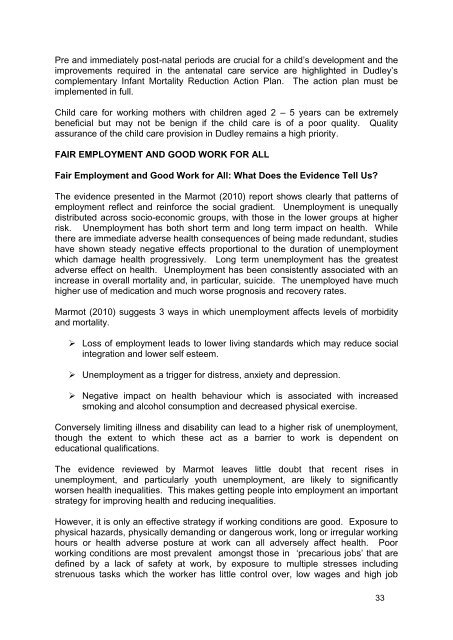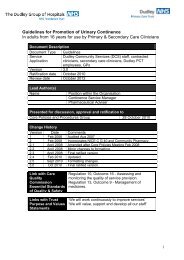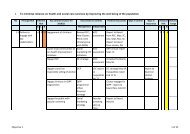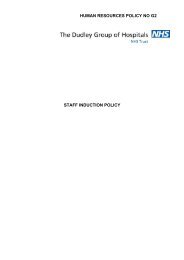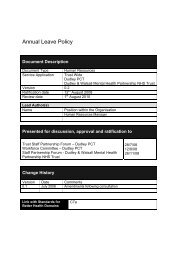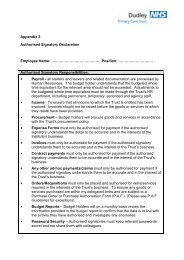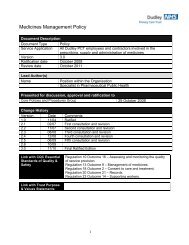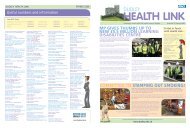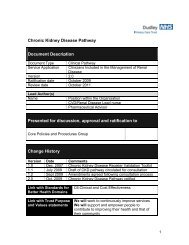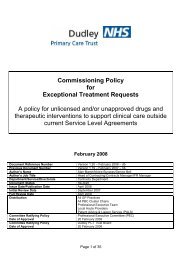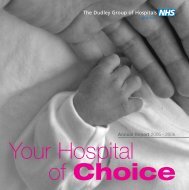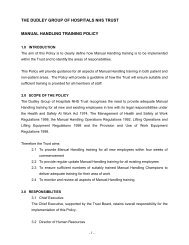Dudley Strategy for Tackling Health Inequalities 2010-15
Dudley Strategy for Tackling Health Inequalities 2010-15
Dudley Strategy for Tackling Health Inequalities 2010-15
- No tags were found...
You also want an ePaper? Increase the reach of your titles
YUMPU automatically turns print PDFs into web optimized ePapers that Google loves.
Pre and immediately post-natal periods are crucial <strong>for</strong> a child‟s development and theimprovements required in the antenatal care service are highlighted in <strong>Dudley</strong>‟scomplementary Infant Mortality Reduction Action Plan. The action plan must beimplemented in full.Child care <strong>for</strong> working mothers with children aged 2 – 5 years can be extremelybeneficial but may not be benign if the child care is of a poor quality. Qualityassurance of the child care provision in <strong>Dudley</strong> remains a high priority.FAIR EMPLOYMENT AND GOOD WORK FOR ALLFair Employment and Good Work <strong>for</strong> All: What Does the Evidence Tell Us?The evidence presented in the Marmot (<strong>2010</strong>) report shows clearly that patterns ofemployment reflect and rein<strong>for</strong>ce the social gradient. Unemployment is unequallydistributed across socio-economic groups, with those in the lower groups at higherrisk. Unemployment has both short term and long term impact on health. Whilethere are immediate adverse health consequences of being made redundant, studieshave shown steady negative effects proportional to the duration of unemploymentwhich damage health progressively. Long term unemployment has the greatestadverse effect on health. Unemployment has been consistently associated with anincrease in overall mortality and, in particular, suicide. The unemployed have muchhigher use of medication and much worse prognosis and recovery rates.Marmot (<strong>2010</strong>) suggests 3 ways in which unemployment affects levels of morbidityand mortality.‣ Loss of employment leads to lower living standards which may reduce socialintegration and lower self esteem.‣ Unemployment as a trigger <strong>for</strong> distress, anxiety and depression.‣ Negative impact on health behaviour which is associated with increasedsmoking and alcohol consumption and decreased physical exercise.Conversely limiting illness and disability can lead to a higher risk of unemployment,though the extent to which these act as a barrier to work is dependent oneducational qualifications.The evidence reviewed by Marmot leaves little doubt that recent rises inunemployment, and particularly youth unemployment, are likely to significantlyworsen health inequalities. This makes getting people into employment an importantstrategy <strong>for</strong> improving health and reducing inequalities.However, it is only an effective strategy if working conditions are good. Exposure tophysical hazards, physically demanding or dangerous work, long or irregular workinghours or health adverse posture at work can all adversely affect health. Poorworking conditions are most prevalent amongst those in „precarious jobs‟ that aredefined by a lack of safety at work, by exposure to multiple stresses includingstrenuous tasks which the worker has little control over, low wages and high job33


